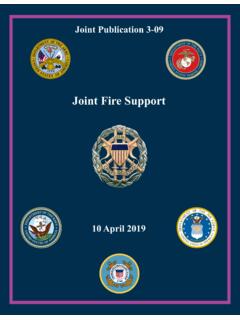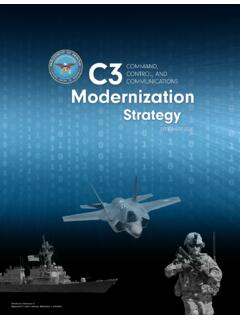Transcription of ATP 3-12.3 ELECTRONIC WARFARE TECHNIQUES
1 ATP ELECTRONIC WARFARE TECHNIQUES JULY 2019 DISTRIBUTION RESTRICTION: Approved for public release; distribution is unlimited. This publication supersedes ATP 3-36, dated 16 December 2014. Headquarters, Department of the Army This publication is available at the Army Publishing Directorate site ( ), and the Central Army Registry site ( ). *ATP RESTRICTION: Approved for public release; distribution is unlimited. *This publication supersedes ATP 3-36, dated 16 December i Army TECHNIQUES Publication No. Headquarters Department of the Army Washington, DC, 16 July 2019 ELECTRONIC WARFARE TECHNIQUES Contents Page v INTRODUCTION .. vii Chapter 1 OVERVIEW OF ELECTRONIC WARFARE .. 1-1 Introduction to ELECTRONIC WARFARE .. 1 -1 ELECTRONIC WARFARE 1-1 electromagnetic Environment .. 1 -2 Chapter 2 ELECTRONIC WARFARE KEY PERSONNEL .. 2-1 ELECTRONIC WARFARE Personnel .. 2-1 Theater Army, Corps, Division and Brigade.
2 2-1 Chapter 3 ELECTRONIC WARFARE PLANNING AND EXECUTION .. 3-1 ELECTRONIC WARFARE Contributions to the Military Decision-Making Process .. 3-1 ELECTRONIC WARFARE Planning Considerations .. 3-1 ELECTRONIC WARFARE Configurations .. 3 -6 Staff Contributions to ELECTRONIC WARFARE Planning .. 3-8 3- 11 ELECTRONIC WARFARE Execution .. 3 - 13 Special Considerations During Execution .. 3- 14 Chapter 4 ELECTRONIC WARFARE PREPARATION AND 4-1 ELECTRONIC WARFARE Preparation .. 4 -1 Integration of ELECTRONIC WARFARE and Signals Intelligence .. 4-2 Chapter 5 ELECTRONIC WARFARE SUPPORT TECHNIQUES .. 5-1 Planning ELECTRONIC WARFARE Support .. 5-1 Preparing ELECTRONIC WARFARE Support .. 5-1 Executing ELECTRONIC WARFARE support .. 5-2 Chapter 6 ELECTRONIC ATTACK TECHNIQUES .. 6-1 Planning ELECTRONIC Attack .. 6-1 Preparing ELECTRONIC Attack .. 6-4 Executing ELECTRONIC Attack .. 6-5 Chapter 7 ELECTRONIC PROTECTION TECHNIQUES .
3 7-1 Commander s ELECTRONIC Protection Responsibilities .. 7-1 Planning ELECTRONIC Protection .. 7 -1 Contents ii ATP electromagnetic Compatibility .. 7-5 electromagnetic Interference .. 7-5 Staff ELECTRONIC Protection Responsibilities .. 7- 10 Equipment and Communications Enhancements .. 7- 10 Appendix A THE electromagnetic spectrum .. A-1 Appendix B JAMMING CALCULATIONS .. B-1 Appendix C ELECTRONIC WARFARE EQUIPMENT AND C-1 Appendix D FORMS, REPORTS, AND MESSAGES .. D-1 GLOSSARY .. Glossary-1 REFERENCES .. References-1 INDEX .. Index-1 Figures Figure 1-1. The electromagnetic spectrum and the electromagnetic environment .. 1-3 Figure 3-1. ELECTRONIC WARFARE in the targeting process .. 3- 13 Figure 5-1. Example of a line-of-bearing .. 5-3 Figure 5-2. Example of a cut .. 5-3 Figure 5-3. Example of a fix .. 5-4 Figure 5-4. Concave baseline .. 5-5 Figure 5-5. Convex baseline .. 5-5 Figure 5-6.
4 Baseline distance .. 5-6 Figure 5-7. Circular error probability .. 5-7 Figure 5-8. False azimuth indicated by refraction error .. 5-8 Figure 5-9. Reflection of a radio wave .. 5-9 Figure 6-1. Spot and barrage jamming .. 6-9 Figure 6-2. Jamming to disrupt enemy battalion to company communications .. 6- 11 Figure 7-1. Threat use of terrain masking .. 7-3 Figure A-1. Department of Defense use of the electromagnetic spectrum .. A-4 Figure A-2. The ionosphere daytime and nighttime composition .. A-7 Figure A-3. The electromagnetic spectrum and communication bands .. A-8 Figure A-4. Relationship between magnetic field strength and current .. A-9 Figure A-5. Amplitude modulation and frequency modulation .. A- 10 Figure A-6. Pulse modulation .. A- 11 Figure A-7. Antenna heights and line of sight distances .. A- 12 Figure A-8. Electric and magnetic fields of a radio wave .. A- 13 Figure A-9. Vertical and horizontal polarization.
5 A- 13 Figure A-10. Circular and elliptical polarization .. A- 14 Figure A-11. Planar wavefront reflection .. A- 15 Figure A-12. Super-refraction ducts .. A- 16 Figure A-13. Diffraction of radio waves around a solid object .. A- 17 16 July 2019 Contents ATP iii Figure A-14. Diffraction of radio waves around a hillside ..A- 17 Figure A-15. Phase shift in multipath interference ..A-19 Figure A-16. Possible routes for ground waves ..A-20 Figure A-17. Relationship between skip zone, skip distance, and ground wave ..A- 21 Figure A-18. Skywave paths ..A-22 Figure A-19. Refraction of frequency below the lowest usable frequency ..A-24 Figure B-1. Example minimum jammer power output calculations ..B-2 Figure B-2. Example maximum jammer power output calculation ..B-3 Figure D-1. Sample joint tactical air strike request .. D-2 Figure D-2. Joint spectrum interference resolution report instructions.
6 D-3 Figure D-3. Stop jamming message instructions .. D-4 Figure D-4. ELECTRONIC WARFARE frequency deconfliction message instructions .. D-4 Figure D-5. ELECTRONIC WARFARE mission summary instructions .. D-5 Figure D-6. ELECTRONIC WARFARE tasking message instructions .. D-7 Tables Table 3-1. Example of an ELECTRONIC WARFARE running estimate .. 3-3 Table 7-1. TECHNIQUES for minimizing transmissions and transmission times .. 7-4 Table 7-2. Common jamming signals .. 7-6 Table 7-3. electromagnetic interference troubleshooting battle drill .. 7-9 Table A-1. Radio wave bands and frequencies ..A-1 Table A-2. Atmosphere layers, features, and their effects on radio waves ..A-5 Table A-3. Ionosphere layers and effects on radio waves ..A-6 Table A-4. The proportional relationship between amplitude and energy ..A-9 Table A-5. Propagation characteristics of terrain ..A-20 Table A-6. Transmission angle and distance.
7 A-23 Table B-1. Formula symbols ..B-1 Table D-1. ELECTRONIC attack request format instructions .. D-1 16 July 2019 This page intentionally left blank. 16 July 2019 ATP v Preface ATP complements the ELECTRONIC WARFARE tactics presented in FM 3-12. ATP supersedes ATP 3-36, dated 16 December principal audience for ATP is ELECTRONIC WARFARE professionals, spectrum managers, unit leaders, and Soldiers assigned to echelons theater army and below. Commanders and staffs of Army headquarters serving as a joint task force or multinational headquarters also use applicable joint or multinational doctrine for command and control of joint or multinational forces. Trainers and educators throughout the Army also use this publication. Commanders, staffs, and subordinates ensure their decisions and actions comply with applicable , international, and, in some cases, host-nation laws and regulations.
8 Commanders at all levels ensure that their Soldiers operate in accordance with the law of war and the rules of engagement (FM 27-10). They also adhere to the Army Ethic as described in ADRP 1. ATP uses joint terms where applicable. Selected joint and Army terms and definitions appear in both the glossary and the text. For definitions shown in the text, the term is italicized, and the number of the proponent publication follows the definition. This publication is not the proponent for any Army terms. ATP applies to the Active Army, Army National Guard/Army National Guard of the United States and United States Army Reserve unless otherwise stated. The proponent for this publication is the United States Army Cyber Center of Excellence. The preparing agency is the Doctrine Branch, United States Army Cyber Center of Excellence. Send comments and recommendations on a DA Form 2028, Recommended Changes to Publications and Blank Forms, to Commander, United States Army Cyber Center of Excellence and Fort Gordon, ATTN: ATZH-ID (ATP ), 506 Chamberlain Avenue, Fort Gordon, GA 30905-5735, by e-mail to This page intentionally left blank.
9 16 July 2019 ATP vii Introduction ATP provides doctrinal guidance and direction to the Army for conducting ELECTRONIC WARFARE during unified land operations . This publication provides a description of ELECTRONIC WARFARE , roles, relationships, responsibilities, and capabilities to support Army and joint operations . ATP nests with and supports joint ELECTRONIC WARFARE doctrine and FM 3-12. It provides the doctrinal context to address the relationship between ADP 3-0 and ADP 5-0. Readers need to review ADP 2-0, ADP 3-0, ADP 5-0, ADP 6-0, ATP , ATP , FM 3-13, and FM 6-0 to understand the fundamentalsof integrating and synchronizing ELECTRONIC WARFARE with unified land provides details on TECHNIQUES and procedures for Army ELECTRONIC WARFARE . This publication includes the fundamentals and guiding principles for ELECTRONIC WARFARE . It provides a cohesive and coherent description of how ELECTRONIC WARFARE supports and enables operations as well as other mission tasks and functions at each echelon.
10 ELECTRONIC WARFARE integrates into operations using already established joint and Army processes such as the intelligence process, targeting and the military decision-making process. This publication includes ELECTRONIC WARFARE staff responsibilities, contributions to the military decision-making process and targeting, and the reliance on intelligence preparation of the battlefield. It describes doctrinal TECHNIQUES to address future operational challenges with current ELECTRONIC WARFARE capabilities. Due to rapidly evolving ELECTRONIC WARFARE capabilities and TECHNIQUES , the Cyber COE will review and update ATP on a frequent basis in order to keep pace with the continuously evolving electromagnetic operational environment. This publication describes ELECTRONIC WARFARE missions and actions within the electromagnetic spectrum and the interrelation of these activities among each other and all Army operations .















